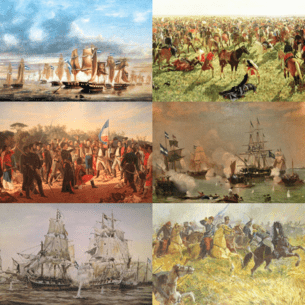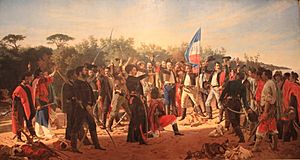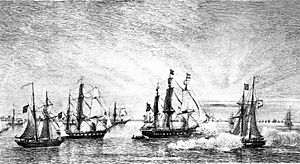Cisplatine War facts for kids
Quick facts for kids Cisplatine War |
|||||||||
|---|---|---|---|---|---|---|---|---|---|
 From top left: Battle of Juncal, Battle of Sarandí, Oath of the Thirty-Three Orientals, Battle of Monte Santiago, Battle of Quilmes, Battle of Ituzaingó |
|||||||||
|
|||||||||
| Belligerents | |||||||||
| Commanders and leaders | |||||||||
|
|
||||||||
| Units involved | |||||||||
| Strength | |||||||||
| 1826: 6,832 regulars 1828: 15,000 |
1826: ~12,000 regulars & militia 1828: 6,000 |
||||||||
The Cisplatine War (also called the Argentine-Brazilian War) was a conflict in the 1820s. It was fought between the United Provinces of the Río de la Plata (which later became Argentina) and the Empire of Brazil. The war was about who would control a region called Cisplatina. This area is known today as Uruguay.
The war happened after both the United Provinces and Brazil gained independence. The United Provinces had broken away from Spain. Brazil had become independent from Portugal. The main result of the war was that Cisplatina became an independent country, the Oriental Republic of Uruguay.
Why the War Started
Early Rebellions and Portuguese Control
The region of Banda Oriental (part of modern-day Uruguay) was led by José Gervasio Artigas. In 1811, this area rebelled against Spanish rule. This happened around the same time as the May Revolution in Buenos Aires. Buenos Aires wanted to be in charge of all the regions that were once part of the Viceroyalty of the Río de la Plata.
From 1814, Artigas's province joined with other areas like Santa Fe and Entre Rios. They formed a group called the Federal League. This group did not want Buenos Aires to control them.
Portugal's Invasion and Annexation
The Portuguese Empire was based in Rio de Janeiro at this time. They wanted to control more land in southern Brazil. In 1816, the Portuguese invaded the Banda Oriental. They defeated Artigas's forces in 1820 at the Battle of Tacuarembó.
After this victory, the Portuguese took over the Banda Oriental. They renamed it Cisplatina. It became a province of the Kingdom of Brazil. This gave Portugal control of the Río de la Plata river and the important port city of Montevideo.
Cisplatina Joins Brazil
Brazil became independent from Portugal in 1822. Cisplatina remained a province of the new Empire of Brazil. It even sent representatives to help write Brazil's first constitution. However, Emperor Pedro I rejected this constitution. He wrote his own in 1824. Under this new constitution, Cisplatina had a lot of freedom.
The Conflict Begins

The United Provinces of the Río de la Plata secretly supported people in Cisplatina. They wanted them to fight against Brazilian rule. The United Provinces wanted to control the region themselves.
Rebels Declare Independence
Rebels like Fructuoso Rivera and Juan Antonio Lavalleja fought against Brazil. On August 25, 1825, leaders from Banda Oriental met in Florida. They declared their independence from Brazil. At the same time, they said they wanted to join the United Provinces.
On October 25, 1825, the United Provinces officially said they would take over Banda Oriental. Brazil responded by declaring war on the United Provinces on December 10, 1825.
The two sides had very different navies. Brazil was a strong naval power. It had 96 warships and a lot of trade. The United Provinces had only a few warships. They also had some small gunboats to protect their ports. Both navies used many British, American, and French officers and sailors. Famous admirals included William Brown for Argentina and James Norton for Brazil.
Brazil quickly blocked the Río de la Plata river. This stopped trade to Buenos Aires. The Argentines tried to break this blockade. They used Brown's ships and also sent out privateers. Privateers were private ships allowed to attack enemy merchant ships. These ships sailed from places like Ensenada and Carmen de Patagones.
The Argentines had some successes. They defeated a Brazilian fleet at the Battle of Juncal. They also fought off a Brazilian attack on Carmen de Patagones. However, Brazil had more ships. By 1828, Brazil's blockade had badly damaged Argentina's navy. It also stopped trade to Buenos Aires, hurting the Argentine government's money.
Land Battles
On land, the Argentine army crossed the Río de la Plata. They set up their base near Durazno. General Carlos María de Alvear led an invasion into Brazilian territory. There were many small fights.
Emperor Pedro I of Brazil planned a counterattack. He gathered an army of Brazilian volunteers and European soldiers. But he had to return to Rio de Janeiro because of other rebellions in Brazil. He gave command of the army to Felisberto Caldeira Brant, Marquis of Barbacena. The Brazilian attack was stopped at the Battle of Ituzaingó.
Ituzaingó was the biggest land battle of the war. Other smaller clashes happened, like the Battle of Sarandí. Brazil struggled to find enough soldiers. By 1828, the war was very expensive and unpopular in Brazil. That year, Rivera took back some territory that was once part of the Eastern Jesuit Missions.
End of the War
Seeking Peace
The war reached a standstill. Argentine and Uruguayan forces could not capture major Brazilian cities. The Brazilian blockade hurt Buenos Aires' economy. Brazil also did not have enough soldiers for a big attack. People in Brazil wanted the war to end. Both sides became interested in peace.
The war was very costly for both sides. It also threatened trade between the United Provinces and the United Kingdom. So, Britain and France helped the two sides talk about peace.
The Peace Treaty
In Rio de Janeiro, the United Provinces and the Empire of Brazil signed the 1828 Treaty of Montevideo. This treaty recognized the independence of Cisplatina. It became the Eastern Republic of Uruguay.
The treaty also gave Brazil control over the eastern part of the former Eastern Jesuit Missions. Most importantly, it made sure that ships could freely use the Río de la Plata river. This was very important for Brazil's safety and trade.
In Brazil, losing Cisplatina made people more unhappy with Emperor Pedro I. This was one reason he gave up his throne in 1831.
What We Remember
Uruguay and Argentina's Heroes
Even though this was not a war for Uruguay's independence from a colonial power, it is seen that way in Uruguay. The Thirty-Three Orientals are national heroes. They are remembered for freeing Uruguay from Brazilian rule. Their landing is called the "Liberation Crusade."
Argentina also remembers the war as a brave fight. The Argentine Navy has named many ships after people and events from this war. William Brown (known as "Guillermo Brown" in Argentina) is seen as the father of the Argentine navy. He is considered a hero for his actions in the war. He is sometimes called the "Nelson of the Río de la Plata."
Brazil and the World
Brazil has not focused much on this war. Few Brazilian historians have studied it in detail. Brazil's national heroes usually come from its own independence or other major wars.
Even though Britain played a role and had officers on both sides, most English-speaking people do not know much about this war.
See also
 In Spanish: Guerra del Brasil para niños
In Spanish: Guerra del Brasil para niños
- Platine Wars
- Brazil–Uruguay relations
- Argentina–Brazil relations
- List of wars involving Brazil
- List of wars involving Argentina


